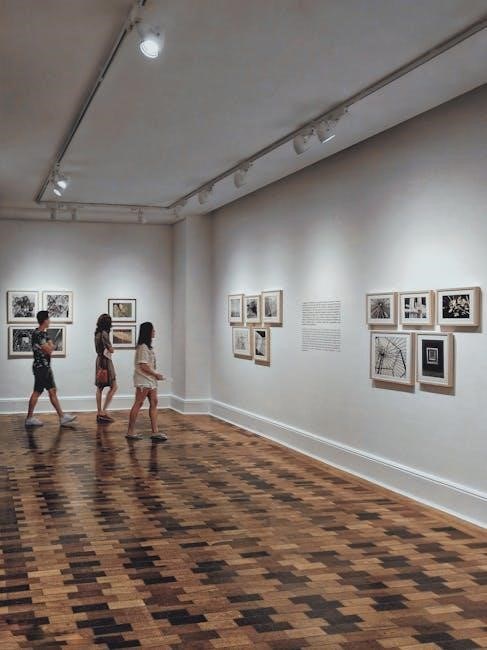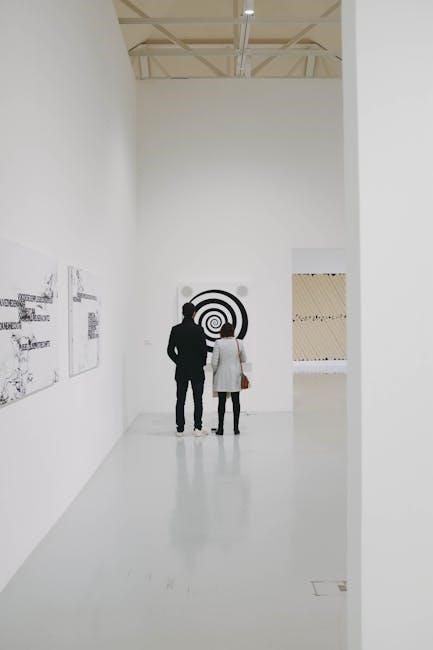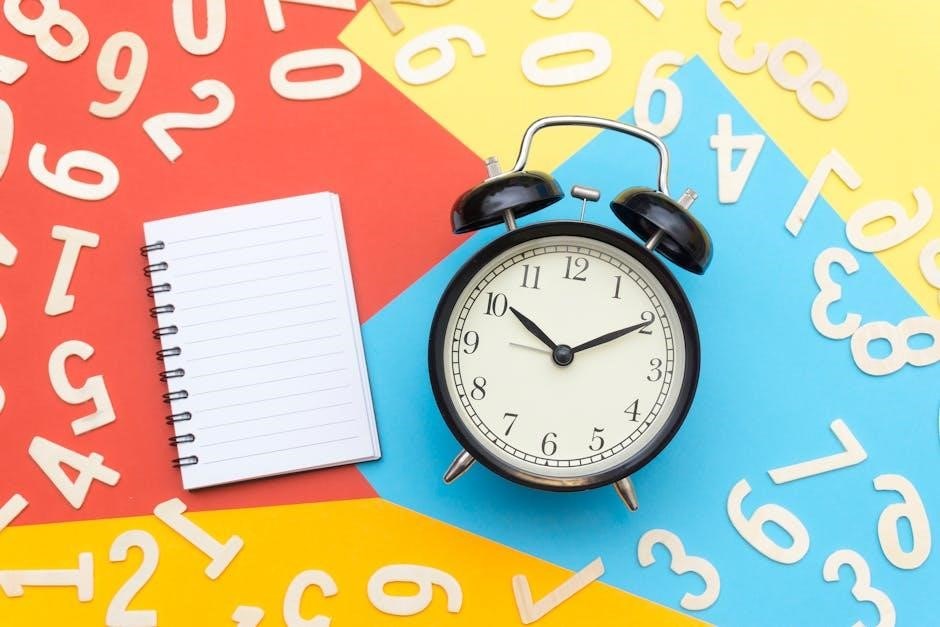
pictures at an exhibition trumpet pdf
Pictures at an Exhibition Trumpet PDF: A Comprehensive Guide
“Pictures at an Exhibition‚” originally composed by Modest Mussorgsky‚ has various trumpet arrangements available in PDF format. These include orchestral parts‚ transcriptions‚ and solo arrangements; Trumpet players can find sheet music for different movements‚ including the famous “Promenade‚” suitable for various skill levels and trumpet types.
Overview of “Pictures at an Exhibition”

“Pictures at an Exhibition‚” a suite in ten movements by Modest Mussorgsky‚ was initially composed for piano in 1874. Inspired by Viktor Hartmann’s artwork‚ each movement depicts a different painting or sketch. The suite is connected by the recurring “Promenade‚” representing the viewer’s walk through the exhibition.
Later orchestrated by Maurice Ravel and others‚ it became a staple in the orchestral repertoire. The piece showcases Mussorgsky’s unique compositional style‚ blending Russian folk melodies with innovative harmonies. Its powerful and evocative nature has made it a favorite among audiences and musicians alike.
The suite includes movements such as “Gnomus‚” “The Old Castle‚” “Tuileries‚” and “The Great Gate of Kiev‚” each offering a distinct musical portrayal of Hartmann’s art. The trumpet plays a crucial role in bringing these musical pictures to life‚ adding grandeur and color to the overall sonic landscape; The work has been adapted for various ensembles‚ including concert band‚ allowing wider accessibility and performance opportunities.
Trumpet Parts Available in PDF Format
Numerous trumpet parts for “Pictures at an Exhibition” are readily available in PDF format‚ catering to various performance needs. These include full orchestral trumpet parts‚ often transcribed and optimized for easy page turning. Such transcriptions are valuable for musicians seeking convenient and accessible versions of the music.
Brian Bindner’s transcriptions are particularly noteworthy‚ offering complete sets of orchestral trumpet parts transposed and formatted for ease of use. Digital downloads provide instant access to these resources‚ enabling quick preparation for rehearsals and performances. Solo trumpet arrangements and duet versions of movements like the “Promenade” are also accessible‚ catering to individual practice and smaller ensemble settings.
Furthermore‚ arrangements for trumpet and piano offer opportunities for solo performance with accompaniment; These PDF resources often include parts for different trumpets‚ such as Bb‚ C‚ and Eb trumpets‚ allowing players to choose instruments based on their preference and the demands of the arrangement. The availability of these digital sheet music options enhances accessibility for students‚ educators‚ and professional musicians alike.
“Promenade” for Trumpet: Sheet Music and Arrangements
The “Promenade” from “Pictures at an Exhibition” is a recurring and iconic theme‚ making it a popular choice for trumpet arrangements. Sheet music for the “Promenade” is widely available in PDF format‚ catering to various ensemble sizes and skill levels. These arrangements range from solo trumpet versions to duets and trios‚ providing versatile options for performance.
Duet arrangements‚ often scored for Trumpet 1 and Trumpet 2‚ allow for collaborative performance and exploration of the melodic and harmonic intricacies of the theme. Solo trumpet arrangements‚ sometimes accompanied by piano‚ offer opportunities for individual expression and virtuosity. Trio arrangements further expand the possibilities‚ creating richer textures and harmonic depth.
These PDF resources frequently include transposed parts for different trumpets‚ such as Bb and C trumpets‚ accommodating players’ instrument preferences. Some arrangements also incorporate variations and embellishments‚ adding a unique flair to the familiar melody. Educational arrangements may simplify the meter and rhythms‚ making the “Promenade” accessible to younger or less experienced players. Whether for concert band‚ brass quintet‚ or solo performance‚ the “Promenade” offers a compelling and recognizable piece for trumpet players of all levels.
Trumpet Transcriptions by Brian Bindner
Brian Bindner is recognized for his trumpet transcriptions of “Pictures at an Exhibition‚” making the orchestral work accessible to trumpet players. His transcriptions are available in PDF format‚ providing a convenient and readily accessible resource for musicians. Bindner’s work focuses on creating practical and playable trumpet parts‚ ensuring that the essence of Mussorgsky’s masterpiece is retained while being idiomatic for the instrument.

These transcriptions include full sets of orchestral trumpet parts‚ meticulously transposed and formatted for easy page turning during performance. This attention to detail is particularly beneficial for live performances‚ minimizing distractions and allowing players to focus on the music. The PDF downloads typically include Trumpet 1 and Trumpet 2 parts in Bb‚ catering to the common instrument choice among trumpet players.
Bindner’s transcriptions aim to provide accurate and reliable versions of the trumpet parts‚ suitable for both study and performance. His work is highly valued by trumpet players seeking to explore “Pictures at an Exhibition” in a practical and engaging way. By offering transposed parts and focusing on usability‚ Brian Bindner contributes significantly to the accessibility and enjoyment of this iconic work for trumpet enthusiasts.
Trumpet Arrangements for Different Skill Levels
“Pictures at an Exhibition” offers a range of trumpet arrangements catering to various skill levels‚ from beginner to advanced players. Simplified versions focus on essential melodies and rhythms‚ making the piece accessible to students. These arrangements often feature less complex passages and reduced ranges‚ allowing developing trumpet players to engage with Mussorgsky’s masterpiece.
Intermediate arrangements present a balance between accessibility and challenge‚ incorporating more intricate musical lines and technical demands. These arrangements may include excerpts from the original orchestral score‚ adapted for solo trumpet or small ensembles. Players at this level can refine their technique and musicality while exploring the rich textures of “Pictures at an Exhibition.”
Advanced arrangements offer the full scope of Mussorgsky’s work‚ demanding high levels of technical proficiency and musical interpretation. These arrangements often feature the complete orchestral trumpet parts‚ requiring players to navigate complex passages‚ wide ranges‚ and demanding articulations. Professional trumpet players and advanced students can use these arrangements to showcase their skills and delve into the intricacies of “Pictures at an Exhibition.” The availability of PDF sheet music ensures easy access to these arrangements for players of all levels.
Using Different Trumpets: Bb‚ C‚ Eb‚ and Piccolo
“Pictures at an Exhibition” presents opportunities to utilize various trumpets‚ each offering unique tonal qualities and technical advantages; The Bb trumpet is the most common‚ providing a versatile sound suitable for many passages. The C trumpet‚ often preferred in orchestral settings‚ offers a brighter‚ more focused tone‚ and its intonation can be advantageous in certain keys.
The Eb trumpet‚ with its higher pitch‚ can add brilliance and agility to specific movements. Its use can create a distinct color‚ especially in passages requiring a lighter‚ more penetrating sound. The piccolo trumpet‚ pitched an octave higher than the standard Bb trumpet‚ is reserved for the most demanding and virtuosic sections. Its bright‚ piercing tone adds excitement and brilliance to the performance.
Some arrangements of “Pictures at an Exhibition” are specifically tailored to these different trumpets‚ exploiting their individual strengths. By carefully selecting the appropriate instrument for each movement‚ trumpet players can enhance the overall performance and bring out the full expressive potential of Mussorgsky’s masterpiece. The availability of PDF sheet music often includes parts transposed for various trumpets‚ facilitating experimentation and informed instrument choices.
Educational Opportunities within the Trumpet Parts
Studying the trumpet parts for “Pictures at an Exhibition” offers significant educational opportunities for musicians of all levels. The music presents a wide range of technical challenges‚ including varied articulations‚ phrasing nuances‚ and dynamic contrasts‚ promoting comprehensive skill development. The score demands a deep understanding of musical expression and interpretation‚ encouraging players to explore the emotional depth of Mussorgsky’s composition.
Analyzing the different trumpet parts exposes students to various musical styles and techniques‚ from the lyrical “Promenade” to the dramatic intensity of other movements. The arrangements often incorporate different trumpet types (Bb‚ C‚ Eb‚ piccolo)‚ each requiring unique embouchure and breath control techniques.
Furthermore‚ studying the transcribed and arranged trumpet parts fosters critical listening skills and encourages a deeper appreciation for orchestration and musical adaptation. Working through the challenges presented by “Pictures at an Exhibition” enhances ensemble playing skills‚ promoting cooperation and communication within a musical group. The availability of PDF sheet music makes this enriching musical experience accessible to a wide range of students and educators.
Digital Sheet Music Options and Availability
Numerous digital platforms offer “Pictures at an Exhibition” trumpet sheet music in PDF format‚ providing convenient access for musicians. These resources include solo arrangements‚ orchestral excerpts‚ and transcriptions tailored for various skill levels. Websites like Sheet Music Plus and Musicnotes.com offer licensed digital downloads‚ ensuring copyright compliance and supporting composers and arrangers. Many arrangements feature transposed parts for Bb trumpet‚ C trumpet‚ and other instruments‚ catering to diverse player preferences.

Digital sheet music provides instant availability‚ allowing musicians to quickly access and print the desired parts. Furthermore‚ the digital format often allows for transposition and resizing‚ accommodating individual needs. Some platforms offer interactive features‚ such as audio samples and practice tools‚ enhancing the learning experience.
Arrangements by Brian Bindner‚ Patrick Roszell‚ and others are readily available‚ providing high-quality transcriptions optimized for page turning and performance. These digital resources significantly simplify the process of acquiring and utilizing “Pictures at an Exhibition” trumpet parts‚ making this masterpiece accessible to a global audience.
Arrangements for Trumpet and Piano
Several arrangements of “Pictures at an Exhibition” for trumpet and piano are available‚ offering a more intimate and accessible performance option compared to the full orchestral version. These arrangements often focus on the most recognizable movements‚ such as “Promenade‚” adapting the orchestral score for trumpet and piano accompaniment. Such versions allow trumpet players to showcase their musicality and technical skills in a duet setting.
These arrangements are suitable for recitals‚ student performances‚ and smaller ensemble concerts. The piano part provides harmonic support and rhythmic drive‚ while the trumpet carries the melodic line. Some arrangements also incorporate different trumpet types‚ such as Bb‚ C‚ or even piccolo trumpet‚ to add variety and color to the performance. Digital sheet music platforms offer downloadable PDF versions of these arrangements‚ facilitating easy access and practice.
Bernard Dewagtere’s arrangement is one notable example‚ offering a Romantic interpretation for trumpet in C and piano. These arrangements provide musicians with the opportunity to explore Mussorgsky’s masterpiece in a versatile and engaging format‚ highlighting the expressive capabilities of both the trumpet and the piano.

Orchestral Trumpet Excerpts and Performance Considerations
When performing orchestral excerpts from “Pictures at an Exhibition‚” trumpet players must consider several factors to deliver an authentic and compelling interpretation. Accuracy in rhythm‚ articulation‚ and dynamics is paramount‚ as these elements contribute significantly to the character of each movement. Particular attention should be paid to Mussorgsky’s original intentions and the nuances of Ravel’s orchestration.
The “Promenade” theme‚ a recurring motif throughout the suite‚ requires a delicate and expressive approach‚ varying in tone and intensity with each appearance. Other movements‚ such as “Samuel Goldenberg and Schmuyle‚” demand careful attention to phrasing and tonal contrast. Trumpet players should study the full score to understand their role within the ensemble and how their part interacts with other instruments.
Technical proficiency is essential to navigate the demands of the piece‚ including wide leaps‚ rapid passages‚ and sustained high notes. Additionally‚ players should consider the historical context and stylistic conventions of the Romantic era to capture the essence of Mussorgsky’s vision. Accessing well-edited scores and parts‚ such as those transcribed by Brian Bindner‚ can aid in accurate and informed performance.
Related Posts

carrier comfortlink alarm codes pdf
Download the comprehensive Carrier ComfortLink alarm codes PDF guide for easy troubleshooting and system maintenance. Get instant access now!
squallywood pdf
Download Squallywood PDF instantly. Get your free copy now!

gottman worksheets for couples pdf
Strengthen your relationship with free Gottman worksheets for couples. Download printable PDFs based on research-backed strategies to improve communication and connection.